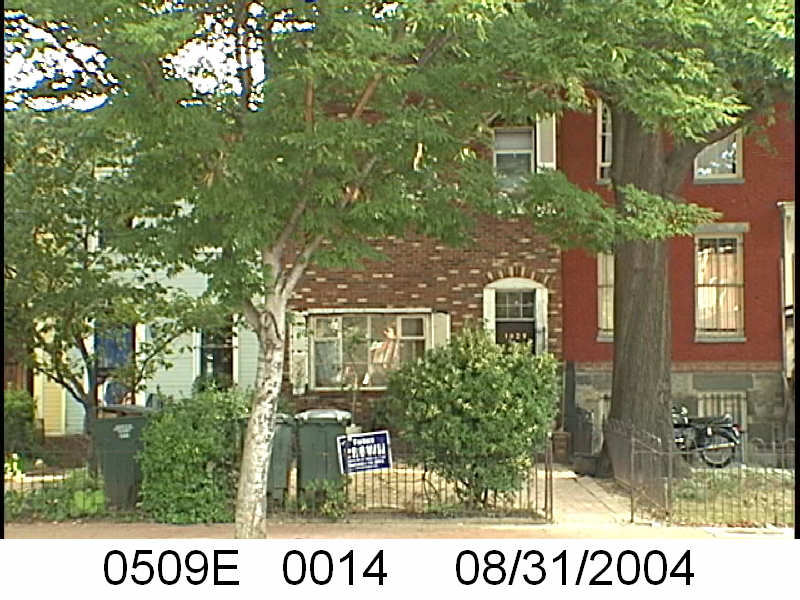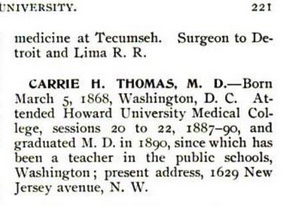When I see the name Carrie, I think of a shy blonde gal who gets blood dumped on her. But this is not a high schooler with supernatural powers, this Carrie is an African American teacher in 1920s Truxton Circle.

Carrie Howard Thomas was born the second daughter to Jefferson Thomas and Mary E. Stevenson on March 5, 1868 in Washington, DC. The 1880 census had her living at 448 O St NW with her dad, who worked as a school janitor, mom, sister and four younger brothers.
By 1900 the family moved to 1629 New Jersey Ave NW, a home that Jefferson Thomas owned. Jefferson was still a school janitor and Carrie was a teacher. But she was no mere school teacher. She was Dr. C.H. Thomas, graduate from Howard University’s medical school. She also has a Wikipedia entry, which in danger of being deleted for her lack of notability. Here is a description of her career from the entry:
She also has a Wikipedia entry, which in danger of being deleted for her lack of notability. Here is a description of her career from the entry:
Prior to the 1880s, there had been no consistent teaching of physical education in Washington D.C. public schools for African American children. Thomas played an early role in overseeing the improvement improving physical education, with Edwin Bancroft Henderson later revolutionizing the system. In 1892, she was appointed Superintendent of Heredity and Hygiene, assisting in supervising physical education.
On June 30 that year, she wrote a report, signed “C.H. Thomas,” detailing visits twice a month to the schools, supervising lesson plans, and observing the physical education classes. Dr. Thomas gave weekly talks to teachers on physical education, hygiene, and other topics covered in the physical education classes. When Thomas resigned the following year, she was succeeded by physical education teacher Mary P. Evans.
In 1896, Thomas was living in Washington D.C., where she represented the Lucy Thurman W.C.T.U. (Women’s Christian Temperance Union” during a convention of the National Federation of Colored Women and the National League of Colored Women. Other convention attendees included Margaret Murray Washington (president of the Federation) and Ida B. Wells.
From at least 1905 through 1915, she was serving in the Women’s Relief Corps. In 1911, Thomas also was serving as treasurer for O.P. Morton Women’s Relief Corps WRC), No. 1. Thomas represented the Potomac at the National Convention for the WRC in 1915, where she was the convention’s official physician.
But let’s talk about her house. As noted above, it belonged to her father Jefferson before her. By the 1910 census Jefferson Thomas had died, leaving the house to his widow, Carrie’s mother, Mary E. Thomas. But when we go to the 1920 census, Jefferson is long dead, Mary E. has died, and Carrie lived alone, the owner of 1629 NJ Ave NW.
Looking at the Recorder of Deeds records, the original Thomas family did not use the property to borrow money. The earliest record is from 1944 when the property is sold by Dr. Thomas’ niece, Marietta Kirby Yetman to a Ms. Eleanor Byrd, who then sold it to Clifford L. Brooks. In Dr. Carrie H. Thomas’ will (probate date 8/20/1930) she left the property to Yetman, who resided in Plainfield, New Jersey. It appears she never married. Dr. Thomas died in 1930 and is buried in Suitland, MD. In Dr. Carrie H. Thomas’ will she left the property to Yetman, who resided in Plainfield, New Jersey.

Do you have any info on 1530 N J Ave? From 1898-1920?
Do you freelance btw?
Oh. 1530 New Jersey Ave NW is the wrong side of NJ Ave for my in depth histories.
But there was a historic survey that covered that block done 10 years ago by Kelsey Associates. There is a scribd portion with the survey in this link- http://eastshawdc.blogspot.com/2012/04/should-east-shaw-be-historic-district.html
I don’t freelance. I might when I retire in 6 to (calculates age of son…..) 15 years from now.
Thank you so much for the link. I reviewed the document and can’t find that address but it is listed on the census documents from 1900 & 1910. Any idea how the address could just disappear? My understanding is that it was a saloon.
Addresses sometimes disappear. Buildings get torn down, people aren’t home/don’t answer the door when the census enumerator comes by or the place was abandoned.
You could try to check if it was a saloon by searching variations of the address on Ancestry or the Library of Congress’ Chronicling America sites.
Thanks, Mari! I know it was a saloon b/c it is listed in several city directories but there is no name for the establishment. It may have become something else during prohibition but I was interested in 1900-1907.
I have been looking on Ancestry and Library of Congress but nothing so far. You do run across a lot of other fascinating information though while you are searching though;-)